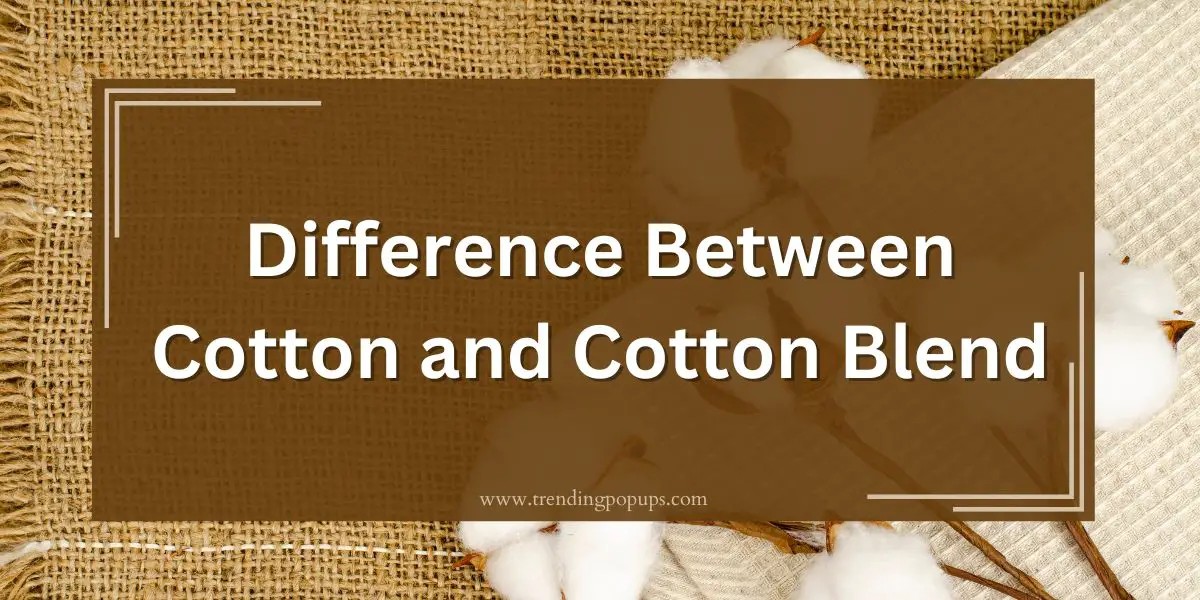In the dynamic world of fabrics, two contenders stand out- cotton and cotton blends. The textile industry relies heavily on these materials, each with its unique qualities and characteristics. Let’s embark on a journey to uncover the differences between these two fabric giants.
Cotton: Nature’s Fiber
Origin and Cultivation
Cotton, known as nature’s fiber, has a rich history dating back centuries. Its cultivation involves meticulous farming practices, primarily in regions with suitable climates. The process from cotton field to fabric is a testament to the dedication of cotton farmers worldwide.
Properties and Characteristics
Known for its breathability and softness, cotton possesses inherent qualities that make it a favorite among consumers. Its natural fibers provide comfort, making it an ideal choice for various types of clothing.
Common Uses in Fabrics
From casual wear to bed linens, cotton finds itself woven into the fabric of our daily lives. T-shirts, jeans, and undergarments are just a few examples of cotton’s extensive usage in the fashion industry.
Also Read: How Long Do Quick Weaves Last? Unlocking the Secrets to Longevity
Cotton Blend: The Fusion Fabric
Definition and Composition
A cotton blend, on the other hand, is a hybrid fabric crafted by combining cotton with other fibers. This fusion enhances the fabric’s performance, addressing some of the limitations associated with pure cotton.
Advantages over Pure Cotton
Cotton blends offer a middle ground between comfort and functionality. The addition of synthetic fibers can impart qualities like increased durability and reduced wrinkling, making these blends suitable for a range of applications.
Popular Blends in the Market
Polyester-cotton, spandex-cotton, and rayon-cotton are popular blends making waves in the market. Each blend caters to specific needs, offering consumers a diverse array of choices.
The Battle: Cotton vs. Cotton Blend
Comfort and Breathability
Cotton’s breathability is unparalleled, providing a cool and airy feel. However, cotton blends, with their added properties, aim to strike a balance between comfort and enhanced functionality.
Durability and Longevity
While pure cotton boasts natural strength, cotton blends introduce a layer of resilience. This aspect becomes crucial for garments subjected to frequent wear and washing.
Maintenance and Care
Cotton often requires delicate care to maintain its quality. Cotton blends, with their synthetic components, tend to be more forgiving in terms of care, making them suitable for the busy modern lifestyle.
Fashion and Style
Cotton in Fashion
The timeless appeal of cotton in the fashion industry remains unmatched. Its versatility allows designers to create an array of styles, from classic to contemporary, catering to diverse consumer preferences.
Trends with Cotton Blends
Cotton blends, with their adaptability, have carved a niche in modern fashion trends. Athleisure wear, for instance, often incorporates blends to provide stretch and flexibility.
Versatility in Clothing
Whether it’s the crispness of pure cotton shirts or the stretch of cotton-blend leggings, both fabrics offer versatility. Choosing between them depends on the desired style and functionality.
Also Read: Dreads vs Braids: A Style Showdown
Environmental Impact
Sustainability of Cotton Farming
Cotton farming has faced scrutiny for its water-intensive nature, but sustainable practices are emerging. Organic and responsibly sourced cotton options aim to minimize environmental impact.
Eco-friendliness of Cotton Blends
The synthetic components in cotton blends raise concerns, yet advancements in eco-friendly fibers contribute to more sustainable options. Consumers can now make choices aligning with their environmental values.
Consumer Choices for a Greener Future
As environmental consciousness grows, consumers play a pivotal role in shaping the industry. Choosing eco-friendly options, whether pure cotton or sustainable blends, contributes to a greener future.
Pricing and Affordability
Cost Factors of Cotton Products
Pure cotton’s pricing is influenced by factors such as farming practices, region, and demand. Understanding these factors allows consumers to make informed decisions based on their budget and preferences.
Value for Money with Cotton Blends
Cotton blends often provide enhanced durability at a competitive price point. Recognizing the value these blends offer ensures consumers get a product that aligns with both their needs and budget.
Consumer Perspectives on Pricing
Balancing quality and cost is a common consideration for consumers. The article explores how individuals weigh the price against the perceived value when making fabric-related decisions.
Choosing the Right Fabric
Considerations for Different Purposes
Selecting between cotton and cotton blends involves understanding the intended use. Casual wear, formal attire, or athletic gear may benefit from different fabric properties.
Matching Fabric to Lifestyle
The article delves into how lifestyle choices, including daily activities and climate, influence the suitability of cotton or cotton blend fabrics.
Making Informed Purchasing Decisions
Empowering consumers with knowledge, this section guides readers on making informed choices, ensuring their fabric selection aligns with their preferences and needs.
DIY and Crafting
Cotton’s Role in DIY Projects
Cotton’s versatility extends to DIY enthusiasts, who can explore various projects from home decor to personalized gifts, leveraging the fabric’s natural properties.
Advantages of Cotton Blends for Crafting
For crafters seeking durability and flexibility, cotton blends open up possibilities. Understanding the advantages helps readers choose the right fabric for their creative endeavors.
Creative Possibilities for Enthusiasts
Inspiring creativity, this section showcases the myriad ways individuals can express themselves through DIY projects using either pure cotton or blends.
Also Read: Unlocking the Golden Elixir: The Amazing Benefits of Saffron for Your Hair
Future Trends
Innovations in Cotton Technology
Technological advancements continually shape the textile industry. This section explores cutting-edge innovations in cotton production and processing.
Emerging Trends in Cotton Blend Textiles
Cotton blends are not static; they evolve with consumer needs. The article anticipates trends in cotton blend textiles and their role in future fashion landscapes.
Anticipated Changes in Consumer Preferences
As consumers become more discerning, their preferences drive industry changes. This section speculates on how consumer attitudes towards cotton and cotton blends may evolve.
Addressing Misconceptions
Common Myths About Cotton
Myths often cloud consumer judgment. This section dispels common misconceptions about pure cotton, ensuring readers have accurate information for decision-making.
Debunking Misconceptions About Cotton Blends
Cotton blends sometimes face unjust criticism. This portion aims to debunk myths surrounding these fabrics, providing a balanced perspective for consumers.
Clarifying Realities for Consumers
Ensuring transparency, this section clarifies the realities of both cotton and cotton blends, empowering readers to make choices based on facts rather than misconceptions.
Expert Opinions
Insights from Textile Experts
Experts in the field weigh in on the qualities, benefits, and considerations of both pure cotton and cotton blends, offering valuable insights to readers.
Views from Fashion Industry Professionals
Fashion industry professionals share their perspectives on the evolving landscape of fabric choices and the role cotton and cotton blends play in shaping fashion trends.
Balancing Perspectives on Fabric Choices
Harmonizing expert opinions, this section provides readers with a well-rounded view, allowing them to make informed decisions based on a comprehensive understanding of cotton and cotton blends.
Conclusion
In conclusion, the choice between cotton and cotton blends boils down to personal preferences, intended use, and lifestyle. Both fabrics have their merits, and understanding their unique characteristics empowers consumers to make decisions aligned with their values and needs. Whether it’s the natural allure of cotton or the enhanced functionality of blends, the textile world offers a diverse array for every individual.
Also Read: The Secret to Conscious Relationships Revealed in ‘Getting the Love You Want’
FAQs
Q: Is cotton blend less breathable than pure cotton?
A: Not necessarily. While pure cotton is renowned for its breathability, modern cotton blends are designed to provide a comfortable wearing experience without compromising on breathability.
Q: What factors affect the pricing of cotton products?
A: Various factors, including farming practices, region of cultivation, and demand, contribute to the pricing of pure cotton products.
Q: Can cotton blends be used for all types of clothing?
A: Yes, cotton blends come in various compositions suitable for different types of clothing, offering versatility in fashion choices.
Q: Are there any ethical concerns with cotton farming?
A: Ethical concerns, such as water usage and fair labor practices, are being addressed through initiatives promoting sustainable and responsible cotton farming.
Q: How can consumers contribute to sustainable fashion?
A: Consumers can make sustainable choices by opting for eco-friendly fabrics, supporting ethical practices, and being mindful of their overall fashion consumption.



